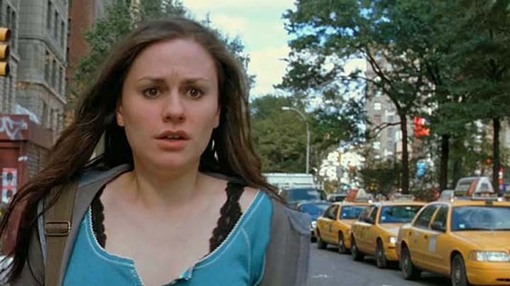View image Marlene Dietrich, “The Scarlet Empress” (Josef von Sternberg, 1935). A pivotal moment of (re-) birth after providing her country with a male heir — though not one fathered by her husband, royal half-wit Grand Duke Peter.
View image “Scarlet Empress”: “… one of those extraordinary women who create their own laws and logic…” Beds, dreams, filters.
Memory starts one image pinging off others across time and movies. Ruminating upon the Close-Up Blog-a-thon at the House Next Door (which, obviously, I can’t stop doing), I see close-ups flowing into and out of one another, dreams within dreams within nightmares, on themes of memory, loss, identity, the process of consciousness and the end of consciousness — you know, the stuff movies are made of.
View image “Once Upon a Time in the West” (Sergio Leone, 1968): Mrs. Jill McBain (Claudia Cardinale) arrives in Sweetwater to find her family slaughtered. After the funeral, she is alone in a big bed in a small room in a vast new land.
View image Final shot, “Once Upon a Time in America” (Sergio Leone, 1984): David “Noodles” Aaronson flops down in an opium den to smoke away his pain and drifts off into a narcotic dream…
In the Godardian spirit of making a movie as a critique/analysis of other movies, here’s a free-association visual essay/commentary on close-ups (with inserts, jump cuts, switchbacks, flashbacks, flash-forwards…) that got synapses firing in my brain as I flipped through shots in my memory — and my DVD collection. Looking back, most of them seem to be filtered, obscured, freeze-framed or reflected faces of characters reaching an impasse or a reckoning — largely from the endings of some of my favorite movies. I wish I could actually cut the film together, so that I could show them in motion, control how long each shot remains on the screen and fiddle with the rhythms (flash cuts, match cuts, reversals of motion), but I don’t know have the technology or the know-how for that at the moment. So, imagine this as a (sometimes perverse) little movie, a “found footage” montage sequence… Kuleshovian, Rorschachian, Hitcockian, Gestaltian, however you want to look at it. I suppose it’s also a look in the mirror.
Hope you can see the associations, juxtapositions, oppositions, contradictions I was going for, although I’m not sure I consciously understand all the leaps myself. They just flowed together this way. Feel free to make your own connections. (And, of course, be aware that you may find spoilers surfacing. With a broadband connection all 38 enlarge-able images should load in about 10 seconds.)
View image Final shot, “McCabe & Mrs. Miller” (Robert Altman, 1971): The camera moves in on Mrs. Miller (Julie Christie), in an opium den while snow drifts outside.
View image Flash cut to final shot of “Petulia” (Richard Lester, 1968): Petulia (Julie Christie), in labor, feels the hand of someone (husband? lover? doctor?) on her cheek just before she blacks out under anaesthesia.
View image Flash cut to final close-up, “Le Boucher” (Claude Chabrol, 1970): Drained and devastated after a long and harrowing night-trip to the hospital, Helene (Stephane Audran) drives herself to a dead end and stares across the impassible river in the cold light of dawn.
View image Flash cut to final freeze-frame close-up, “The 400 Blows” (by Chabrol’s New Wave compatriot, Francois Truffaut, 1959): Antoine Doinel (Jean-Pierre Leaud) reaches the ocean at the edge of the continent. Where to go from here?
View image Flash cut to final moment of final shot: “Nights of Cabiria” (1957) (Federico Fellini): Cabiria (Giulietta Masina) pulls herself together, puts her game face on, looks into the camera and smiles through tears in a tender moment of quiet triumph. Another of the most famous movie-ending close-ups.
December 14, 2012


